Blue steak, also called blue rare steak is simply the rare steak. Its done temp rests between 115°F-120°F while rare steak is done at 130°F. The best blue steaks are made from tenderloin since it’s the leanest cut of beef. It is cooked hot and fast to sear the exterior, leaving the steak’s interior virtually unexposed to heat.
As a pitmaster, I have prepared this highly-ordered menu item severally. I made my fair share of mistakes along the way before I perfected my technique. Since I have a pretty good idea of where most people go wrong, let me walk you through this.
I put together this article to air out what blue steak really is, the cuts you should use, and what you shouldn’t. Stick around to know the texture and taste of blue steak and a simple recipe to enjoy.
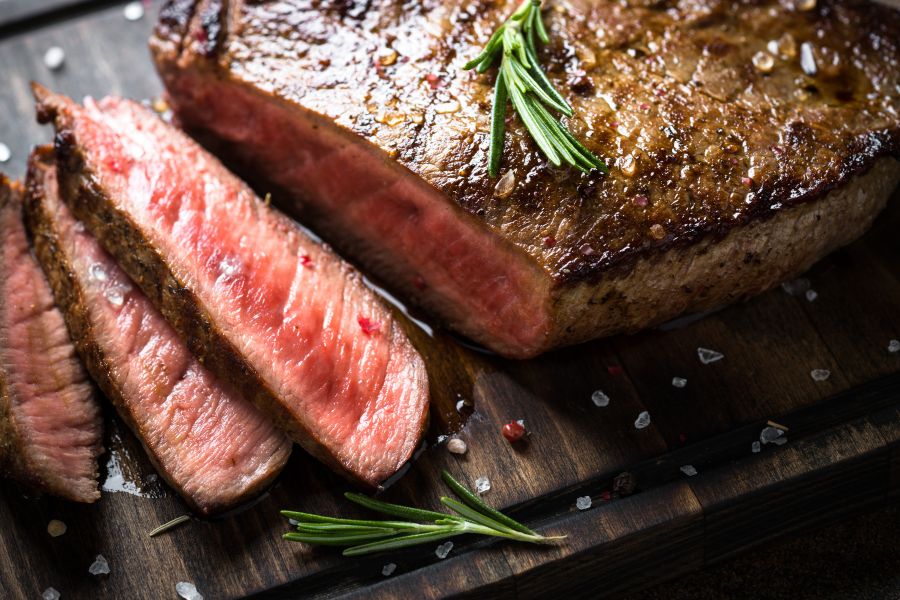
So why blue? There hasn’t been a consensus but there are 2 theories that make convincing arguments. They are:
The first and most viable theory in my opinion is French Au Bleu. It refers to a popular method of cooking trout in France. An Au Bleu trout is cooked in boiling water that’s been seasoned with vinegar, immediately after slaughter without scaling.
Many restaurants went along with this wording, calling barely cooked or almost utterly raw steak ‘bleu’, thus the name.
The other theory depends wholly on myoglobin. Myoglobin is a protein in the blood that’s responsible for supplying much-needed oxygen to your body.
When myoglobin is exposed to oxygen for an extended period, the iron in the muscle starts to deteriorate, turning your meat brownish.
To lengthen the shelf life of beef steaks, they are vacuum-sealed after processing and before distribution. Vacuum sealing involves drawing all the oxygen out of the packaging to create an anaerobic environment.
When myoglobin is deprived of oxygen, it turns purple. However, when oxygen is re-introduced, it regains its red color. This explains why the meat in your grocery store looks a bit purplish. It is in a vacuum.
Steaks that have been packaged using the MAP, Modified Atmosphere Packaging, will have a weaker purple hue because the process involves replacing some of the oxygen in the package with other gases.
This is another reason why it’s called a blue steak.
Before you get to the cooking part, you must know how to pick out the best cut of meat for your blue steak recipe. Make no mistake, if you pick wrong, you won’t enjoy it.
The best cut of meat for blue steak is tenderloin steak since it’s very lean. Here are my top picks for the best cuts for blue steak:
The tenderloin cut is also known as fillet, filet mignon, or eye fillet depending on where you come from.
It’s the leanest cut of beef and is cut from the loin of a steer. These muscles hardly get any exercise, making it a very soft and tender cut. It is the perfect cut for cooking blue steak.
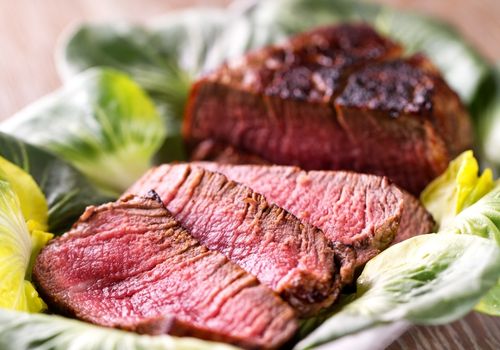
Considered the second-leanest beef cut, flat iron steaks are cut from the chuck area of a steer.
Recent innovations in the grilling world have made it possible to trim most of the fat off this cut, giving us the flat iron we drool over today. It’s to make both rare and medium rare steak. So, if you can’t get your hands on tenderloin, a flat iron is your next safe bet for blue steak.
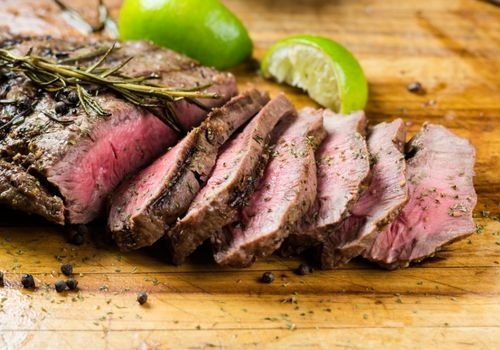
The sirloin tip is cut from the round cut. Since this muscle bears some weight, it’s not as tender as flat iron or tenderloin but it is still a fairly tender cut.
The sirloin steak is packed full of beefy flavor and is a good option for blue steak in the absence of flat iron and tenderloin steaks.
Related Reading
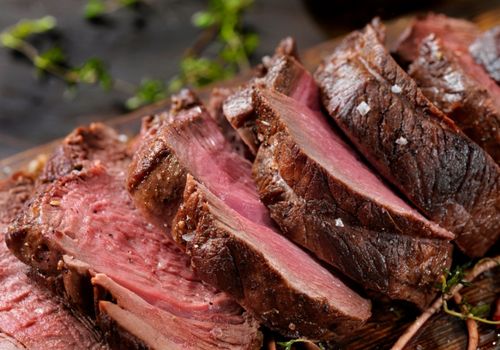
Now that you know which cuts are best for blue steak, here are the cuts you shouldn’t cook blue and why:
Related Reading
The internal temperature of a done blue rare steak ranges between 115°F- 120°F. This makes it the rarest of steaks, closely followed by the usual rare steak which is considered done at 130°F.
If you take your blue steak off the heat at a temperature lower than 115, it will be raw and still cold inside. If the temperature gets past 120°F, you are serving rare steak, not blue.
The USDA recommends cooking beef steaks to a minimum internal temp of 145°F as measured by a digital probe or meat thermometer. This applies to all steaks and roasts.
If you’re a cautious feeder, rare blue steak doesn’t make the cut. However, blue steak enthusiasts are convinced that when cooked properly, blue steaks can be safe to eat.
They argue that bacteria on steaks are only found on the surface and that these bacteria can be destroyed by searing the top and bottom as well as the sides and edges of the blue steaks. If you get the searing technique right, your blue steaks will be safe to eat.
It’s also important to sterilize the tongs you use as you cook. Don’t use the same pair of tongs to handle raw or undercooked meat and cooked meat to avoid transferring bacteria to the food you intend to consume.
Alternatively, use a different pair of tongs to take the steak out of the heat source.
If you’ve never had blue steak, you might be wondering how it tastes. Well, the first bite, which will include a piece of the nicely-seared bark will taste pretty much like steak.
The second bite which will largely be comprised of the ‘bleu’ region will have a bold, beefy flavor that stands out but without much moisture content compared to rare steak.
Blue steak cooking demands an incredibly short time on the skillet, leaving no time for the meat juices to move toward the meat’s surface.
You should also be prepared to transition from a warm, well-seasoned exterior to a cool, bland taste towards the center.
Blue steak, like sugarless coffee, has a unique flavor profile that’s often an acquired taste.
The texture of blue steak is spongy and chewy. This texture is brought on by a lack of sufficient exposure to heat that breaks down and softens meat fibers.
With blue steak, your teeth will have to do all the tenderizing. Many steak lovers appreciate this satisfying texture.
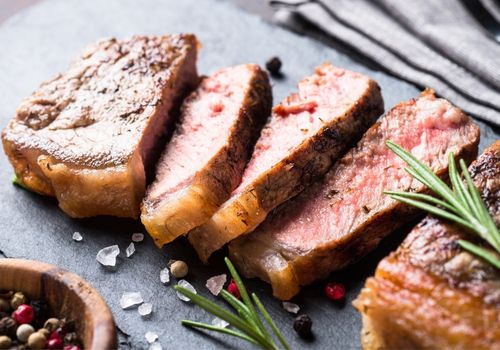
Blue rare steaks are similar but not identical to rare steaks. Blue steaks are cooked for a comparatively shorter period until the internal temp gets to 115°F. Its entire outer surface is seared, while the largest part of the interior remains red.
Rare steaks are cooked longer, to an internal temperature of at least 120°F. The exterior will be well-seared just like with blue steaks. The interior will have a red section in the middle surrounded by a pink hue around the edges. The pink is an indicator that the steak has been cooked longer.
Aside from blue and rare, there is one more popular steak option that’s commonly mistaken for blue steak. It is known as Pittsburgh steak.
It is also called Chicago-style rare or black and blue steak. The phrase, black and blue, is a reference to the cooking method which involves charring or blackening the exterior of the cut while keeping the interior red.
Today, the name Pittsburgh rare is used to reference a steak that has been charred regardless of the internal temperature.
Here is my simple delicious recipe for blue steak you can whip up on a grill or a cast iron skillet:
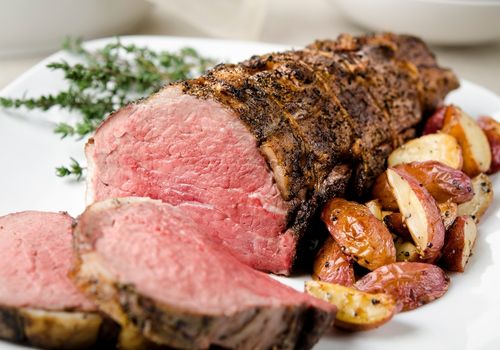
The hardest steak to find is Wagyu steak which is why it’s highly priced.
There is no proof that eating blue steak is healthier than eating other steaks.
Blue steak won’t be cold in the middle, nor hot. It will feel warm to the touch.